标签:str append info 特定 file_path ase 程序设计 sha rod
一、主题式网络爬虫设计方案(15分)
1.主题式网络爬虫名称
基于xpath的瓜子二手车网数据爬取和分析
2.主题式网络爬虫爬取的内容与数据特征分析
爬取内容:瓜子二手车网上每一辆车的标题信息、上牌的时间、表显里程、排量、变速箱类型、价格和新车的指导价格。数据特征分析:在获取的数据中,可以把汽车的上牌时间、表显里程、排量和价格进行数据统计和可视化,其中可以把上牌时间、价格、表显里程进行可视化,构建数据分析模型,进行分析。
3.主题式网络爬虫设计方案概述(包括实现思路与技术难点)
实现思路:
(1)验证请求头信息User-Agent,使用requests请求网页,运行并观察返回值,是200,表示正确,进行下一步操作。否则检查程序再操作。
(2)利用lxml库中etree解析网页
(3)观察HTML网页结构,注意父节点和子节点,同时利用xpath获取ul标签下的li标签。
(4)遍历li标签,获取li标签下的每一辆车详情页面的url
(5)遍历每一辆车详情页面的url,利用xpath语法获取所需要的数据,并利用循环翻页获取更多数据。
(6)使用DataFrame把数据写入特定位置
技术难点:
(1)要注意在获取数据时xpath语法的正确表示,否则会出错;
(2)网页可能遭遇反爬,需进行相关反爬操作;
(3)需使用xpath进行双重遍历;
①首先遍历获取li标签下的url;
②再对每个获取到的url进行遍历。
二、主题页面的结构特征分析(15分)
1.主题页面的结构特征
按F12打开页面,观察html代码,可以清楚的看到每一辆汽车对应着代码上的一个li标签,同时每一个li标签下都包含每一辆车详情页面的url。
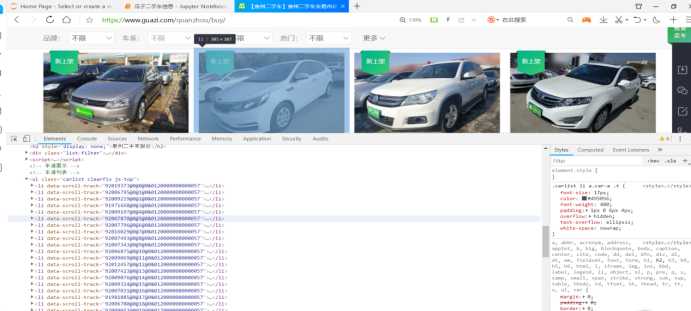
2.Htmls页面解析
利用lxml库中etree解析网站页面,观察详情页面代码结构并使用xpath获取需要内容。
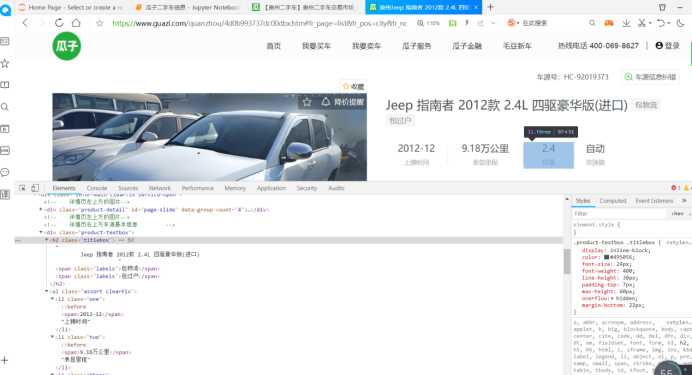
3.节点(标签)查找方法与遍历方法
节点查找方法是利用xpath获取ul下的li标签,要注意xpath使用的语法规则,要按照规则编写代码,获取内容。遍历方法采用循环遍历,包括遍历li标签、遍历详情页面url、实现翻页操作。
三、网络爬虫程序设计(60分)
爬虫程序主体要包括以下各部分,要附源代码及较详细注释,并在每部分程序后面提供输出结果的截图。
1.数据爬取与采集
#!/usr/bin/python3 #_*_coding:utf-8 _*_ #@Author:zhuangqiyuan #@title:瓜子二手车数据的爬取和分析 #导入包 import requests from lxml import etree from bs4 import BeautifulSoup from pandas import DataFrame import os page=1 #标识请求头 headers ={ ‘User-Agent‘: ‘Mozilla/5.0 (Windows NT 10.0; WOW64) AppleWebKit/537.36 (KHTML, like Gecko) Chrome/70.0.3538.25 Safari/537.36 Core/1.70.3741.400 QQBrowser/10.5.3863.400‘, ‘Cookie‘: ‘uuid=8bcc429c-029f-4d45-8de8-f88fb0ca2c78; cityDomain=quanzhou; user_city_id=79; ganji_uuid=3211364230579822430047; lg=1; antipas=58B0581931382V16140z6Q; clueSourceCode=%2A%2300; preTime=%7B%22last%22%3A1575860416%2C%22this%22%3A1575789163%2C%22pre%22%3A1575789163%7D; sessionid=276e0d0e-d04f-4bea-f47d-41826a7e8721; cainfo=%7B%22ca_a%22%3A%22-%22%2C%22ca_b%22%3A%22-%22%2C%22ca_s%22%3A%22seo_baidu%22%2C%22ca_n%22%3A%22default%22%2C%22ca_medium%22%3A%22-%22%2C%22ca_term%22%3A%22-%22%2C%22ca_content%22%3A%22-%22%2C%22ca_campaign%22%3A%22-%22%2C%22ca_kw%22%3A%22%22%2C%22ca_i%22%3A%22-%22%2C%22scode%22%3A%22-%22%2C%22keyword%22%3A%22-%22%2C%22ca_keywordid%22%3A%22-%22%2C%22display_finance_flag%22%3A%22-%22%2C%22platform%22%3A%221%22%2C%22version%22%3A1%2C%22client_ab%22%3A%22-%22%2C%22guid%22%3A%228bcc429c-029f-4d45-8de8-f88fb0ca2c78%22%2C%22ca_city%22%3A%22quanzhou%22%2C%22sessionid%22%3A%226b581614-2868-43a0-d015-508d9830fd27%22%7D; Hm_lvt_936a6d5df3f3d309bda39e92da3dd52f=1575789164,1575793823,1575860415; Hm_lpvt_936a6d5df3f3d309bda39e92da3dd52f=1575860415; close_finance_popup=2019-12-09 ‘ } file_path = os.path.join(os.path.dirname(os.path.abspath(__file__)), ‘guaziershou_data.csv‘) #csv文件命名 def get_detail_urls(url): #定义获取li标签下详情页面url的函数 # 获取页面数据 resp = requests.get(url, headers=headers) text = resp.content.decode(‘utf-8‘) # print(text) # 解析网页 html = etree.HTML(text) # print(html) ul=html.xpath(‘//ul[@class="carlist clearfix js-top"]‘)[0] # print(ul) lis = ul.xpath(‘./li‘) # print(lis) detail_urls = [] for li in lis: detail_url = li.xpath(‘./a/@href‘) detail_url = ‘https://www.guazi.com‘ + detail_url[0] # print(detail_url) detail_urls.append(detail_url) return detail_urls def xiangxi_url(url): #定义获取详情页面数据的函数 text = requests.get(url, headers=headers) resp = text.content.decode(‘utf-8‘) html = etree.HTML(resp) # print(html) title = html.xpath(‘//div[@class="product-textbox"]/h2/text()‘)[0] #根据xpath语法规则编写代码,获取数据 title = title.replace(r‘\r\n‘, ‘‘).strip() # print(title) title1=title.split(r‘ ‘) print(title) infos ={} shangpai = html.xpath(‘//ul[@class="assort clearfix"]/li/span/text()‘)[0] # print(shangpai) shangpai1 =shangpai.split(r‘-‘) #进行数据分割,获取需要数据 spdata=shangpai1[0] print(spdata) biaoxian = html.xpath(‘//ul[@class="assort clearfix"]/li/span/text()‘)[1] # print(biaoxian) biaoxian1=biaoxian.split(r‘万‘) oldkm=biaoxian1[0] print(oldkm) pailiang = html.xpath(‘//ul[@class="assort clearfix"]/li/span/text()‘)[2] print(pailiang) biansu = html.xpath(‘//ul[@class="assort clearfix"]/li/span/text()‘)[3] print(biansu) jiage = html.xpath(‘//span[@class="pricestype"]/text()‘)[0] # print(jiage) jiage1 = jiage.split(r‘¥‘) # print(jiage1) jiage2 = jiage1[1] print(jiage2) newjiage = html.xpath(‘//span[@class="newcarprice"]/text()‘)[0] newjiage = newjiage.replace(r‘\r\n‘, ‘‘).strip() # print(newjiage) newjiage1 = newjiage.split(r‘万‘) # print(newjiage1) newjiage2 = newjiage1[0] print(newjiage2) infos[‘title‘]=title infos[‘spdata‘] = spdata infos[‘oldkm‘] = oldkm infos[‘pailiang‘] = pailiang infos[‘biansu‘] = biansu infos[‘jiage‘] = jiage2 infos[‘newjiage‘] =newjiage2 df = DataFrame(infos, index=[0]) return infos def main(): base_url = ‘https://www.guazi.com/quanzhou/buy/o{}/‘ with open(r‘E:\guaziershouche\guaziershou.csv‘, ‘a‘, encoding=‘utf-8‘) as f: for x in range(1,51): #循环实现翻页 url=base_url.format(x) detail_urls = get_detail_urls(url) #调用函数获取数据 # print(detail_urls) for detail_url in detail_urls: infos=xiangxi_url(detail_url) df = DataFrame(infos, index=[0]) if os.path.exists(file_path): # 字符编码采用utf-8 df.to_csv(file_path, header=False, index=False, mode="a+", encoding="utf_8_sig") #写入数据 else: df.to_csv(file_path, index=False, mode="w+", encoding="utf_8_sig") if __name__ == ‘__main__‘: main()
2.对数据进行清洗和处理
2.1使用DataFrame进行数据加载
#使用DataFrame进行数据加载 import pandas as pd df = pd.read_excel(r‘E:\untitled\guaziershou\guaziershou_data.xlsx‘) df.name="瓜子二手车信息" df.head()
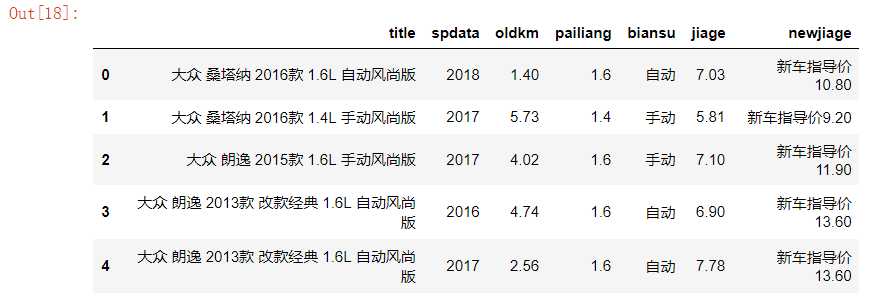
2.2删除无效列
#删除无效列 df.drop(‘biansu‘,axis=1,inplace=True) df.head()

2.3数据重复值处理
#数据重复值处理 df.duplicated()
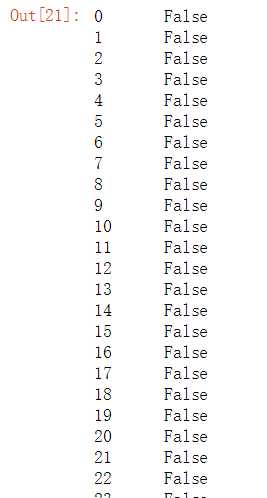
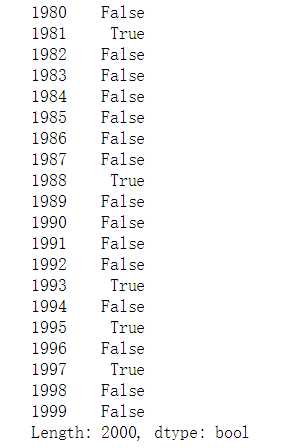
2.4删除重复值
#删除重复值 df =df.drop_duplicates() df.tail()

2.5对数据进行空值处理
#对数据进行空值处理 df[‘newjiage‘].isnull().value_counts()

2.6异常值处理
#异常值处理 df.describe()
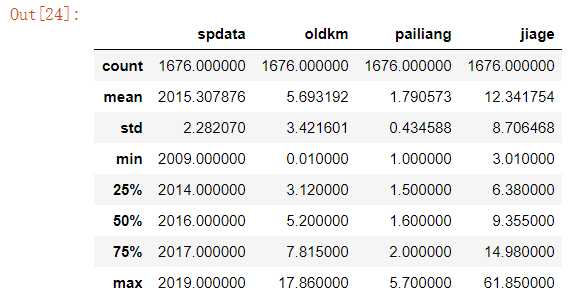
3.数据分析与可视化
3.1用regplot方法绘制回归图
#利用regplot方法绘制回归图,并构建数据分析模型 import seaborn as sns import pandas as pd #利用数据分析模型查看上牌时间和价格之间的分布情况 import matplotlib.pyplot as plt df=pd.read_excel(r‘E:\untitled\guaziershou\guaziershou_data.xlsx‘) plt.rcParams[‘font.sans-serif‘]=[‘SimHei‘] plt.rcParams[‘axes.unicode_minus‘] = False sns.regplot( df.spdata,df.jiage)
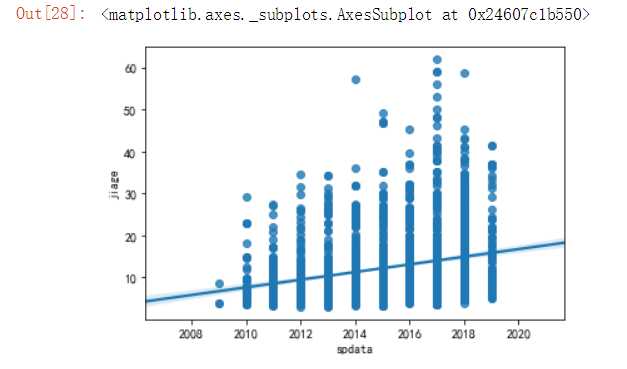
3.2查看表显里程和价格之间的分布情况
#利用数据分析模型查看表显里程和价格之间的分布情况 import seaborn as sns import pandas as pd import matplotlib.pyplot as plt df=pd.read_excel(r‘E:\untitled\guaziershou\guaziershou_data.xlsx‘) plt.rcParams[‘font.sans-serif‘]=[‘SimHei‘] plt.rcParams[‘axes.unicode_minus‘] = False sns.regplot( df.oldkm,df.jiage)
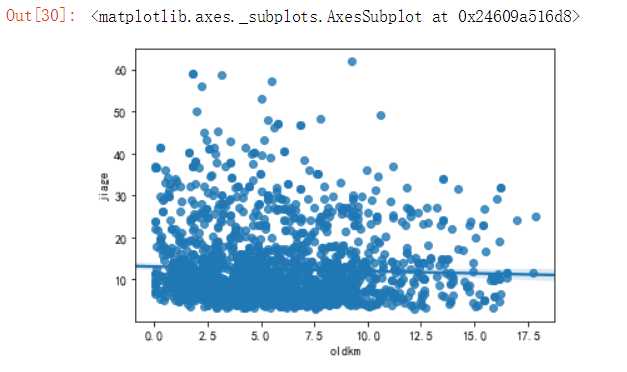
3.3查看上牌时间和表显里程之间的分布情况
#利用数据分析模型查看上牌时间和表显里程之间的分布情况 import seaborn as sns import pandas as pd import matplotlib.pyplot as plt df=pd.read_excel(r‘E:\untitled\guaziershou\guaziershou_data.xlsx‘) plt.rcParams[‘font.sans-serif‘]=[‘SimHei‘] plt.rcParams[‘axes.unicode_minus‘] = False sns.regplot( df.spdata,df.oldkm)
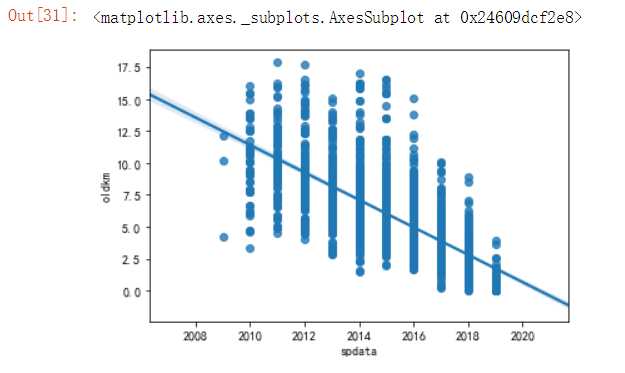
3.4查看汽车排量情况的分布
#查看汽车排量情况的分布 import pandas as pd df = pd.read_excel(r‘E:\untitled\guaziershou\guaziershou_data.xlsx‘) df[‘pailiang‘].value_counts()

3.5根据排量情况绘图
#根据排量情况绘图 import pandas as pd import numpy as np import matplotlib.pyplot as plt plt.rcParams[‘font.sans-serif‘]=[‘SimHei‘] plt.rcParams[‘axes.unicode_minus‘] = False plt.ylabel(‘数量‘) plt.xlabel(‘排量‘) plt.bar([‘1.4T‘,‘1.5T‘,‘1.6T‘,‘1.8T‘,‘2.0T‘],[201,368,462,193,478]) plt.show() plt.ylabel(‘数量‘) plt.xlabel(‘排量‘) plt.xticks(range(0,24,1),rotation=70) plt.bar(["1.0T","1.2T","1.3T","1.4T","1.5T","1.6T","1.7T","1.8T","1.9T","2.0T","2.2T","2.3T","2.4T","2.5T","2.7T","3.0T","3.5T","3.6T","3.8T","4.0T","4.6T","5.7T"],[23,22,23,201,368,462,1,193,2,478,1,4,90,43,6,62,7,5,1,6,1,1]) plt.show()
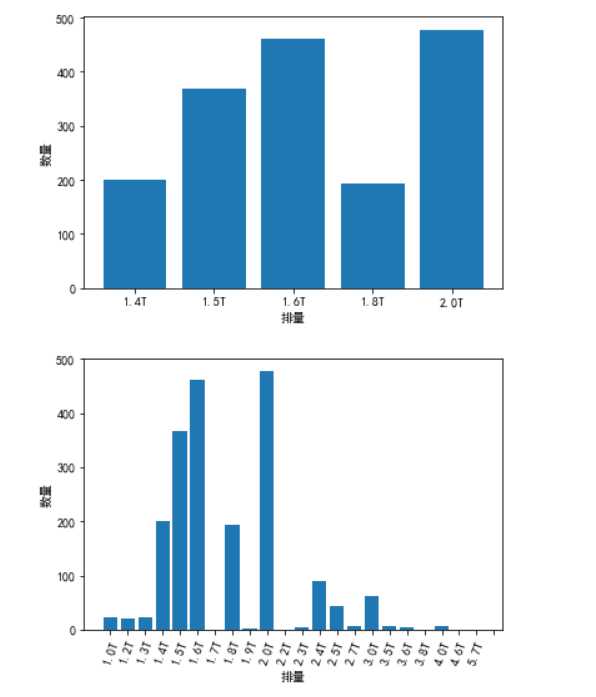
3.6查看变速箱类型的分布情况
#查看变速箱类型的分布情况 import pandas as pd df = pd.read_excel(r‘E:\untitled\guaziershou\guaziershou_data.xlsx‘) df[‘biansu‘].value_counts()

3.7绘制变速箱类型的统计情况图
import matplotlib.pyplot as plt import pandas as pd import matplotlib.pyplot as plt plt.rcParams[‘font.sans-serif‘]=[‘SimHei‘] df = pd.read_excel(r‘E:\untitled\guaziershou\guaziershou_data.xlsx‘) labes=[‘自动‘,‘手动‘] fracs=[1644,356] explode=[0,0.1] plt.pie(x=fracs,labels=labes,autopct="%.0f%%",explode=explode,shadow=True) plt.show() plt.rcParams[‘axes.unicode_minus‘] = False plt.ylabel(‘数量‘) plt.xlabel(‘变速箱类型‘) plt.bar([‘自动‘,‘手动‘],[1644,356]) plt.show()
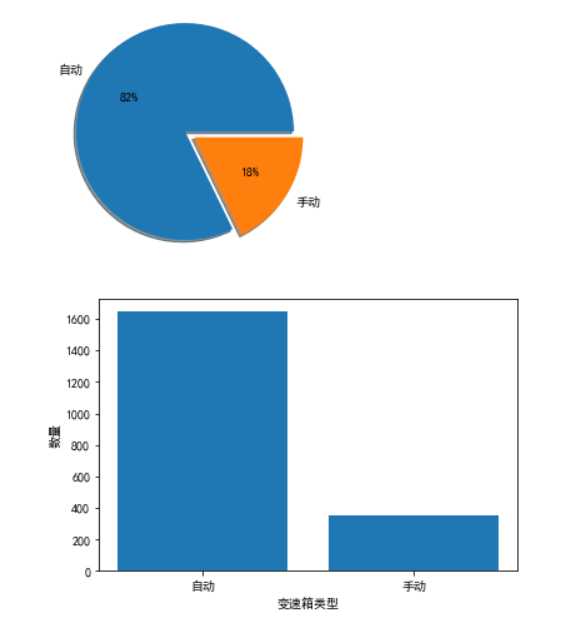
4.数据持久化
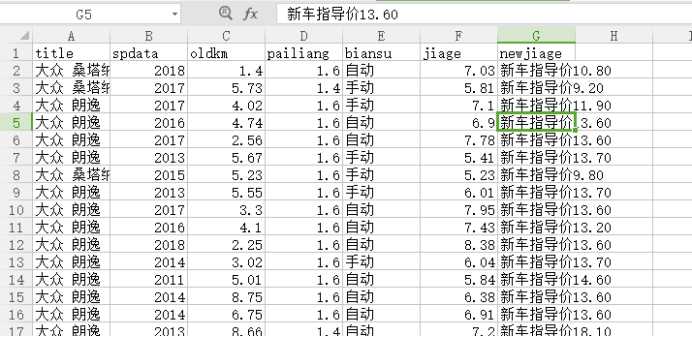
四、结论(10分)
1.经过对主题数据的分析与可视化,可以得到哪些结论?
(1)二手车上牌的时间越早车的价格越低,表显里程数越大
(2)二手车排量集中分布于1.4T-2.0T
(3)二手车的变速箱类型分自动和手动,其中自动类型的车占比较高
(4)二手车的价格普遍分布在6-9万左右,表显里程分布在4万公里左右
2.对本次程序设计任务完成的情况做一个简单的小结。
本次作业遇见了好几个问题,给我留下最深印象的就是处理反爬问题。我在爬取数据的过程中总是报错(IndexError: list index out of range),开始的时候我去搜索了这个错误,但是网上的解释都是关于空元素等的,这与我的情况不相符合,最后通过查询资料得知,一些网站为了反爬,会限制用户的浏览器的标识(User-Agent)还有为了辨别用户身份储存在用户本地终端上的数据(Cookie)。我们在爬虫的时候,主要是想要获取网页的数据,而网页则是不想让我们进行获取。所以我们需要进行各种各样的伪装,上面的几个请求头都是让我们伪装成浏览器,让对方识别我们为爬虫的概率更小,让我们爬取到想要的数据。最后,通过添加相应的请求头,数据终于可以正常爬取,同时我也根据网络上的知识学习了一下如何突破网站的反爬机制。
标签:str append info 特定 file_path ase 程序设计 sha rod
原文地址:https://www.cnblogs.com/zhuangqiyuan/p/12054232.html